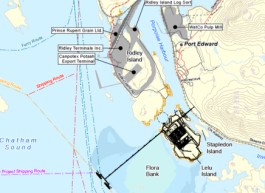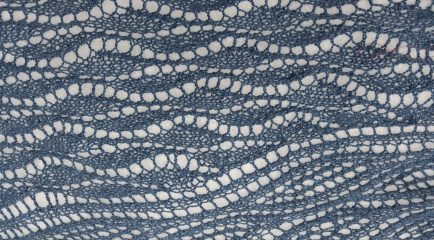I’m just coming to the end of a lace project called Estuary, by designer Emily Wessel. I was first drawn to knit this shawl by its name. Emily describes her inspiration for this design: An estuary is an in-between place, not ocean, yet no longer river. It is a fertile habitat where sweet and salt water mix, and many species thrive. Estuary combines two lace patterns to create an ambiguous shape: not quite a shawl, yet something more than a scarf.
There are more beautiful – extravagant, filigreed, starbursts, leafy, vine trellised – lace patterns. But I’ve been knitting this shawl to honour the Skeena estuary. In it, I see the Flora Banks emerging as the tide retreats, the salmon finding their way back up the river after their time at sea, all the young smolts collecting in adolescent jitteriness after their first river descent. Both coming and going they feed the eagles, the sea lions, the gulls, the seals. And us too. So many of us fed for thousands of years.
The shawl has been a difficult project for me, partly because I’ve picked it up and put it down many times over the past year, but also because the pattern is complex. By combining two different patterns, it mimics the sweet water meeting the salt and you need to pay very careful attention as it grows.
Lace is often like this. Lose concentration and you can find yourself and your stitches in a muddle. And the thing about knitting lace is it’s almost impossible to correct mistakes. The structure, with all its intentional gaps, the pulling together and drawing apart of threads, means you can’t just unravel it and pick it up again like you can with a plain sock or sweater. The structure you’ve laboured so long to create disappears.
 |
| Photo: Tavish Campbell |
 If you plunk an LNG port* on Lelu Island, stretch a bridge across
Flora Banks and the eelgrass where salmon smolt gather to the tanker
dock at the edge of Chatham Sound, drill, blast, dredge and set up a
huge humming structure complete with gas flares and tankers, well you’ve
unravelled something that’s taken thousands of years to emerge from the
debris of our last ice age.
If you plunk an LNG port* on Lelu Island, stretch a bridge across
Flora Banks and the eelgrass where salmon smolt gather to the tanker
dock at the edge of Chatham Sound, drill, blast, dredge and set up a
huge humming structure complete with gas flares and tankers, well you’ve
unravelled something that’s taken thousands of years to emerge from the
debris of our last ice age.How ironic to even consider building this example of Anthropocene hubris in this spot. If you add the expansion to the fracking chaos of northeastern BC this project will necessitate to its enormous greenhouse gas emissions, you’ll be speeding up the final melting of ice that began the process, thousands of years ago to create the Skeena estuary. The melting could well see the whole LNG structure itself lost beneath tidal surges within decades.
Maybe we should send Justin Trudeau, Catherine McKenna and Christy Clark each a fragment of unravelling lace and see how well they can pick up the stitches to re-establish the pattern. All while treading water.
* If you want to know more about Petronas’s LNG project, a project approved by the Canadian government just days before it ratified the Paris agreement on climate change, check out Skeena Watershed Conservation Coalition’s video.
Thanks to Graeme Pole for the images from No More Pipelines.



No comments:
Post a Comment